Reviewing Qualitative and Quantitative Methods in Health Articles
VerifiedAdded on 2023/06/11
|11
|3680
|294
Report
AI Summary
This report provides a detailed review of evidence-based practice in health and social care, focusing on two articles related to clinical interventions for older adults. The first article explores the subjective impact of Tai Chi on physical and mental health among older adults at risk for ischemic stroke, utilizing qualitative research methods to understand perceived benefits. The second article employs a quantitative comparative study to examine strategies for recruiting and retaining older adults in intervention studies. The report discusses the characteristics of qualitative and quantitative research methods, the research methods used in each article, and assesses the validity and reliability of the data. Ultimately, the review highlights the importance of both qualitative and quantitative approaches in improving the quality of health and well-being for older populations, emphasizing the role of evidence-based practice in informing healthcare decisions. Desklib offers a range of resources, including past papers and solved assignments, for students studying healthcare and research.

ARTICLE
Paraphrase This Document
Need a fresh take? Get an instant paraphrase of this document with our AI Paraphraser
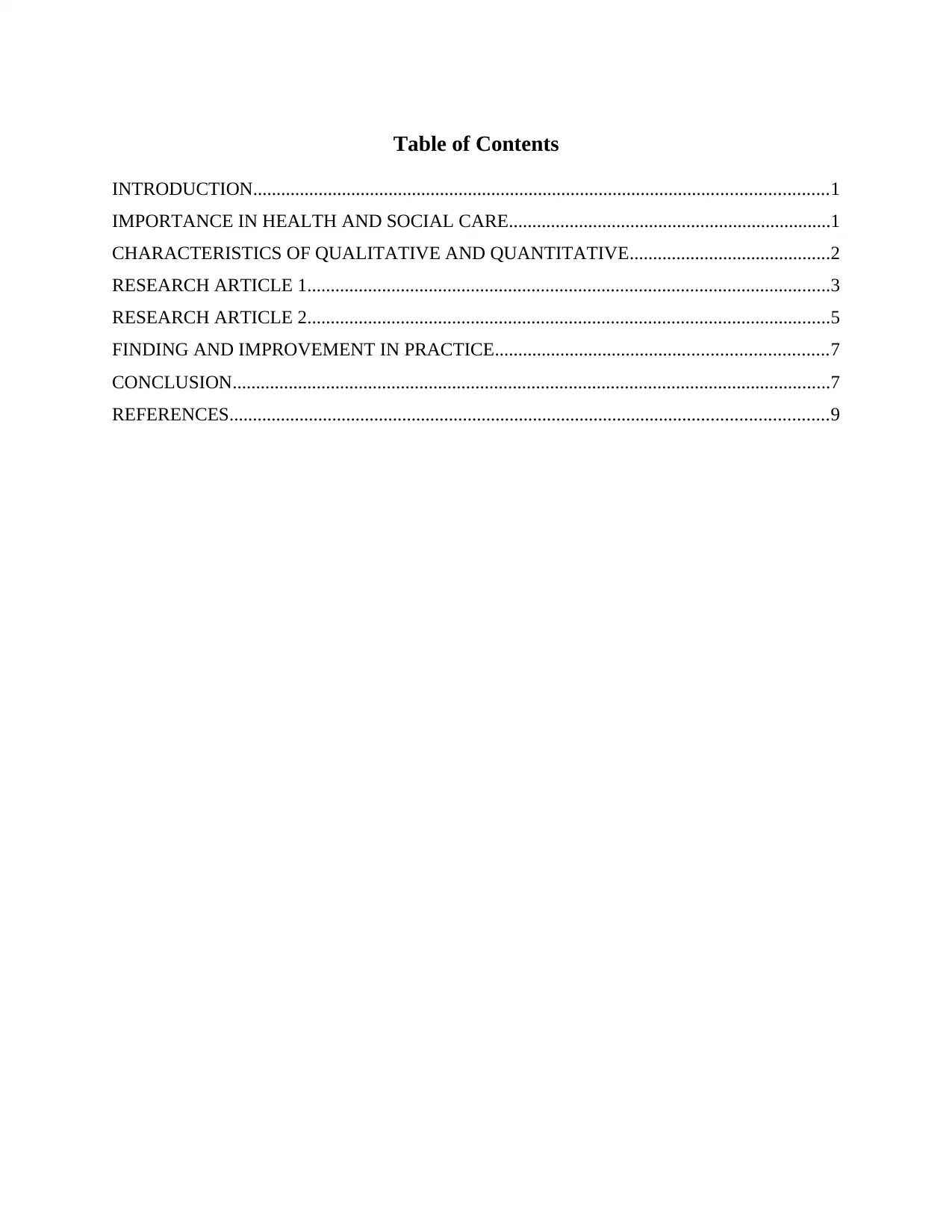
Table of Contents
INTRODUCTION...........................................................................................................................1
IMPORTANCE IN HEALTH AND SOCIAL CARE.....................................................................1
CHARACTERISTICS OF QUALITATIVE AND QUANTITATIVE...........................................2
RESEARCH ARTICLE 1................................................................................................................3
RESEARCH ARTICLE 2................................................................................................................5
FINDING AND IMPROVEMENT IN PRACTICE.......................................................................7
CONCLUSION................................................................................................................................7
REFERENCES................................................................................................................................9
INTRODUCTION...........................................................................................................................1
IMPORTANCE IN HEALTH AND SOCIAL CARE.....................................................................1
CHARACTERISTICS OF QUALITATIVE AND QUANTITATIVE...........................................2
RESEARCH ARTICLE 1................................................................................................................3
RESEARCH ARTICLE 2................................................................................................................5
FINDING AND IMPROVEMENT IN PRACTICE.......................................................................7
CONCLUSION................................................................................................................................7
REFERENCES................................................................................................................................9
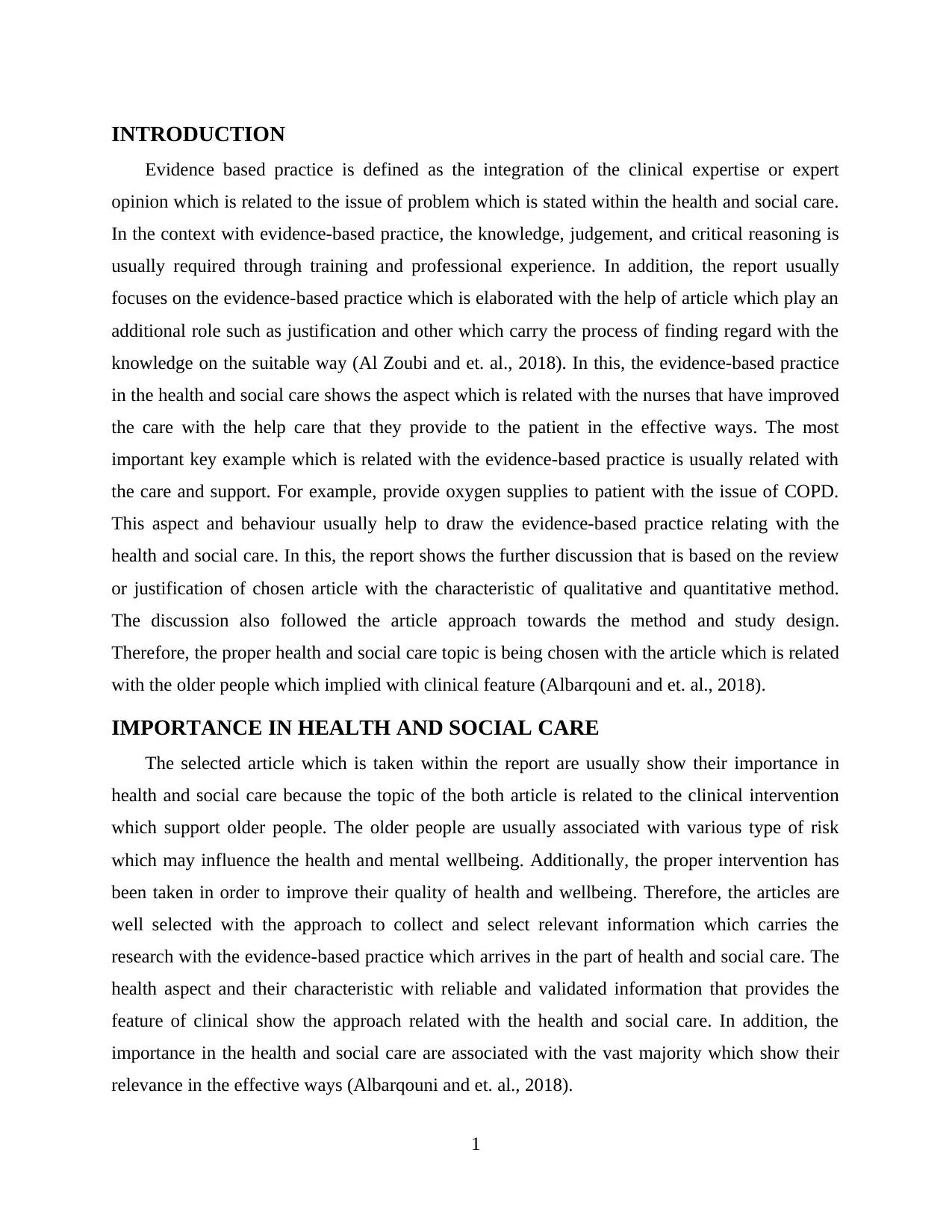
INTRODUCTION
Evidence based practice is defined as the integration of the clinical expertise or expert
opinion which is related to the issue of problem which is stated within the health and social care.
In the context with evidence-based practice, the knowledge, judgement, and critical reasoning is
usually required through training and professional experience. In addition, the report usually
focuses on the evidence-based practice which is elaborated with the help of article which play an
additional role such as justification and other which carry the process of finding regard with the
knowledge on the suitable way (Al Zoubi and et. al., 2018). In this, the evidence-based practice
in the health and social care shows the aspect which is related with the nurses that have improved
the care with the help care that they provide to the patient in the effective ways. The most
important key example which is related with the evidence-based practice is usually related with
the care and support. For example, provide oxygen supplies to patient with the issue of COPD.
This aspect and behaviour usually help to draw the evidence-based practice relating with the
health and social care. In this, the report shows the further discussion that is based on the review
or justification of chosen article with the characteristic of qualitative and quantitative method.
The discussion also followed the article approach towards the method and study design.
Therefore, the proper health and social care topic is being chosen with the article which is related
with the older people which implied with clinical feature (Albarqouni and et. al., 2018).
IMPORTANCE IN HEALTH AND SOCIAL CARE
The selected article which is taken within the report are usually show their importance in
health and social care because the topic of the both article is related to the clinical intervention
which support older people. The older people are usually associated with various type of risk
which may influence the health and mental wellbeing. Additionally, the proper intervention has
been taken in order to improve their quality of health and wellbeing. Therefore, the articles are
well selected with the approach to collect and select relevant information which carries the
research with the evidence-based practice which arrives in the part of health and social care. The
health aspect and their characteristic with reliable and validated information that provides the
feature of clinical show the approach related with the health and social care. In addition, the
importance in the health and social care are associated with the vast majority which show their
relevance in the effective ways (Albarqouni and et. al., 2018).
1
Evidence based practice is defined as the integration of the clinical expertise or expert
opinion which is related to the issue of problem which is stated within the health and social care.
In the context with evidence-based practice, the knowledge, judgement, and critical reasoning is
usually required through training and professional experience. In addition, the report usually
focuses on the evidence-based practice which is elaborated with the help of article which play an
additional role such as justification and other which carry the process of finding regard with the
knowledge on the suitable way (Al Zoubi and et. al., 2018). In this, the evidence-based practice
in the health and social care shows the aspect which is related with the nurses that have improved
the care with the help care that they provide to the patient in the effective ways. The most
important key example which is related with the evidence-based practice is usually related with
the care and support. For example, provide oxygen supplies to patient with the issue of COPD.
This aspect and behaviour usually help to draw the evidence-based practice relating with the
health and social care. In this, the report shows the further discussion that is based on the review
or justification of chosen article with the characteristic of qualitative and quantitative method.
The discussion also followed the article approach towards the method and study design.
Therefore, the proper health and social care topic is being chosen with the article which is related
with the older people which implied with clinical feature (Albarqouni and et. al., 2018).
IMPORTANCE IN HEALTH AND SOCIAL CARE
The selected article which is taken within the report are usually show their importance in
health and social care because the topic of the both article is related to the clinical intervention
which support older people. The older people are usually associated with various type of risk
which may influence the health and mental wellbeing. Additionally, the proper intervention has
been taken in order to improve their quality of health and wellbeing. Therefore, the articles are
well selected with the approach to collect and select relevant information which carries the
research with the evidence-based practice which arrives in the part of health and social care. The
health aspect and their characteristic with reliable and validated information that provides the
feature of clinical show the approach related with the health and social care. In addition, the
importance in the health and social care are associated with the vast majority which show their
relevance in the effective ways (Albarqouni and et. al., 2018).
1
⊘ This is a preview!⊘
Do you want full access?
Subscribe today to unlock all pages.

Trusted by 1+ million students worldwide
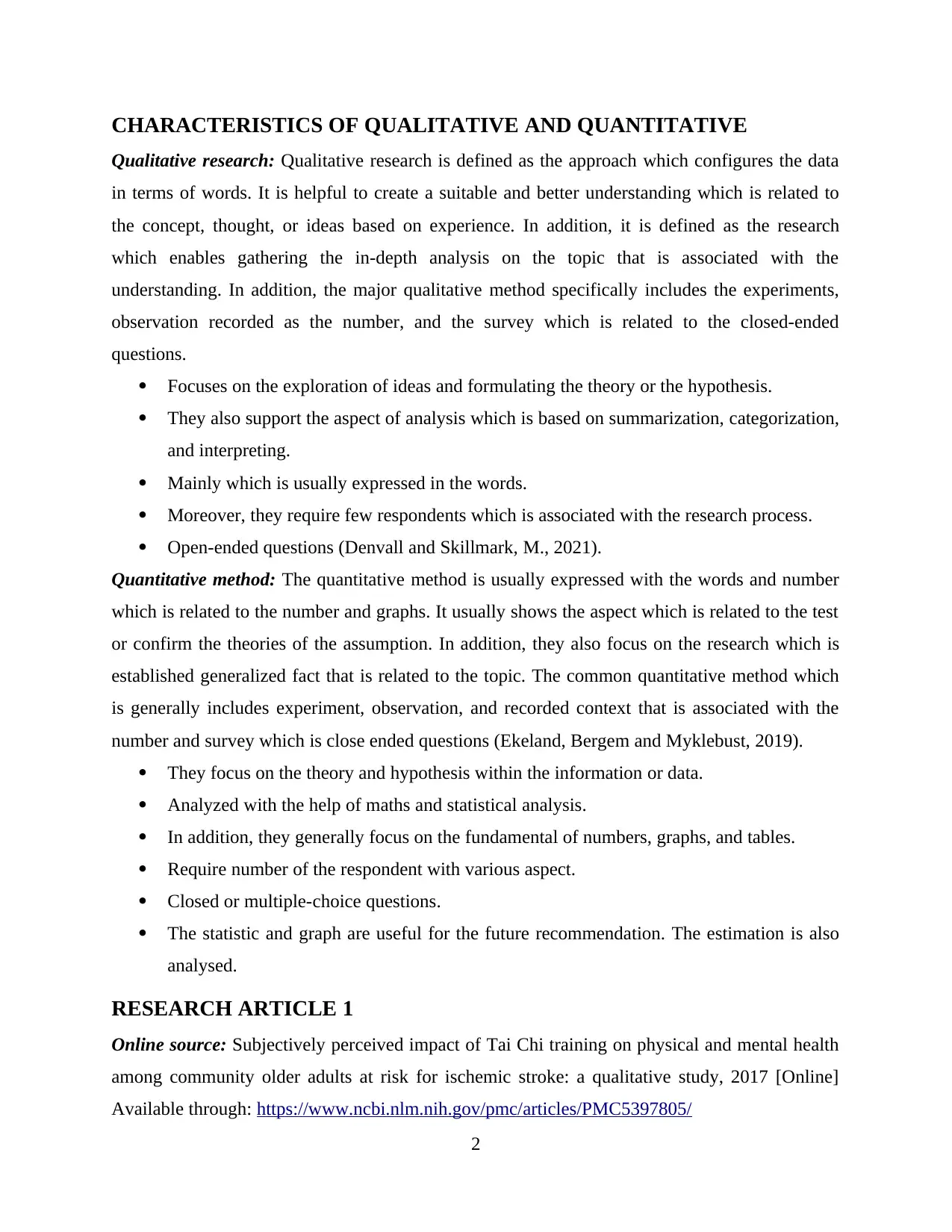
CHARACTERISTICS OF QUALITATIVE AND QUANTITATIVE
Qualitative research: Qualitative research is defined as the approach which configures the data
in terms of words. It is helpful to create a suitable and better understanding which is related to
the concept, thought, or ideas based on experience. In addition, it is defined as the research
which enables gathering the in-depth analysis on the topic that is associated with the
understanding. In addition, the major qualitative method specifically includes the experiments,
observation recorded as the number, and the survey which is related to the closed-ended
questions.
Focuses on the exploration of ideas and formulating the theory or the hypothesis.
They also support the aspect of analysis which is based on summarization, categorization,
and interpreting.
Mainly which is usually expressed in the words.
Moreover, they require few respondents which is associated with the research process.
Open-ended questions (Denvall and Skillmark, M., 2021).
Quantitative method: The quantitative method is usually expressed with the words and number
which is related to the number and graphs. It usually shows the aspect which is related to the test
or confirm the theories of the assumption. In addition, they also focus on the research which is
established generalized fact that is related to the topic. The common quantitative method which
is generally includes experiment, observation, and recorded context that is associated with the
number and survey which is close ended questions (Ekeland, Bergem and Myklebust, 2019).
They focus on the theory and hypothesis within the information or data.
Analyzed with the help of maths and statistical analysis.
In addition, they generally focus on the fundamental of numbers, graphs, and tables.
Require number of the respondent with various aspect.
Closed or multiple-choice questions.
The statistic and graph are useful for the future recommendation. The estimation is also
analysed.
RESEARCH ARTICLE 1
Online source: Subjectively perceived impact of Tai Chi training on physical and mental health
among community older adults at risk for ischemic stroke: a qualitative study, 2017 [Online]
Available through: https://www.ncbi.nlm.nih.gov/pmc/articles/PMC5397805/
2
Qualitative research: Qualitative research is defined as the approach which configures the data
in terms of words. It is helpful to create a suitable and better understanding which is related to
the concept, thought, or ideas based on experience. In addition, it is defined as the research
which enables gathering the in-depth analysis on the topic that is associated with the
understanding. In addition, the major qualitative method specifically includes the experiments,
observation recorded as the number, and the survey which is related to the closed-ended
questions.
Focuses on the exploration of ideas and formulating the theory or the hypothesis.
They also support the aspect of analysis which is based on summarization, categorization,
and interpreting.
Mainly which is usually expressed in the words.
Moreover, they require few respondents which is associated with the research process.
Open-ended questions (Denvall and Skillmark, M., 2021).
Quantitative method: The quantitative method is usually expressed with the words and number
which is related to the number and graphs. It usually shows the aspect which is related to the test
or confirm the theories of the assumption. In addition, they also focus on the research which is
established generalized fact that is related to the topic. The common quantitative method which
is generally includes experiment, observation, and recorded context that is associated with the
number and survey which is close ended questions (Ekeland, Bergem and Myklebust, 2019).
They focus on the theory and hypothesis within the information or data.
Analyzed with the help of maths and statistical analysis.
In addition, they generally focus on the fundamental of numbers, graphs, and tables.
Require number of the respondent with various aspect.
Closed or multiple-choice questions.
The statistic and graph are useful for the future recommendation. The estimation is also
analysed.
RESEARCH ARTICLE 1
Online source: Subjectively perceived impact of Tai Chi training on physical and mental health
among community older adults at risk for ischemic stroke: a qualitative study, 2017 [Online]
Available through: https://www.ncbi.nlm.nih.gov/pmc/articles/PMC5397805/
2
Paraphrase This Document
Need a fresh take? Get an instant paraphrase of this document with our AI Paraphraser
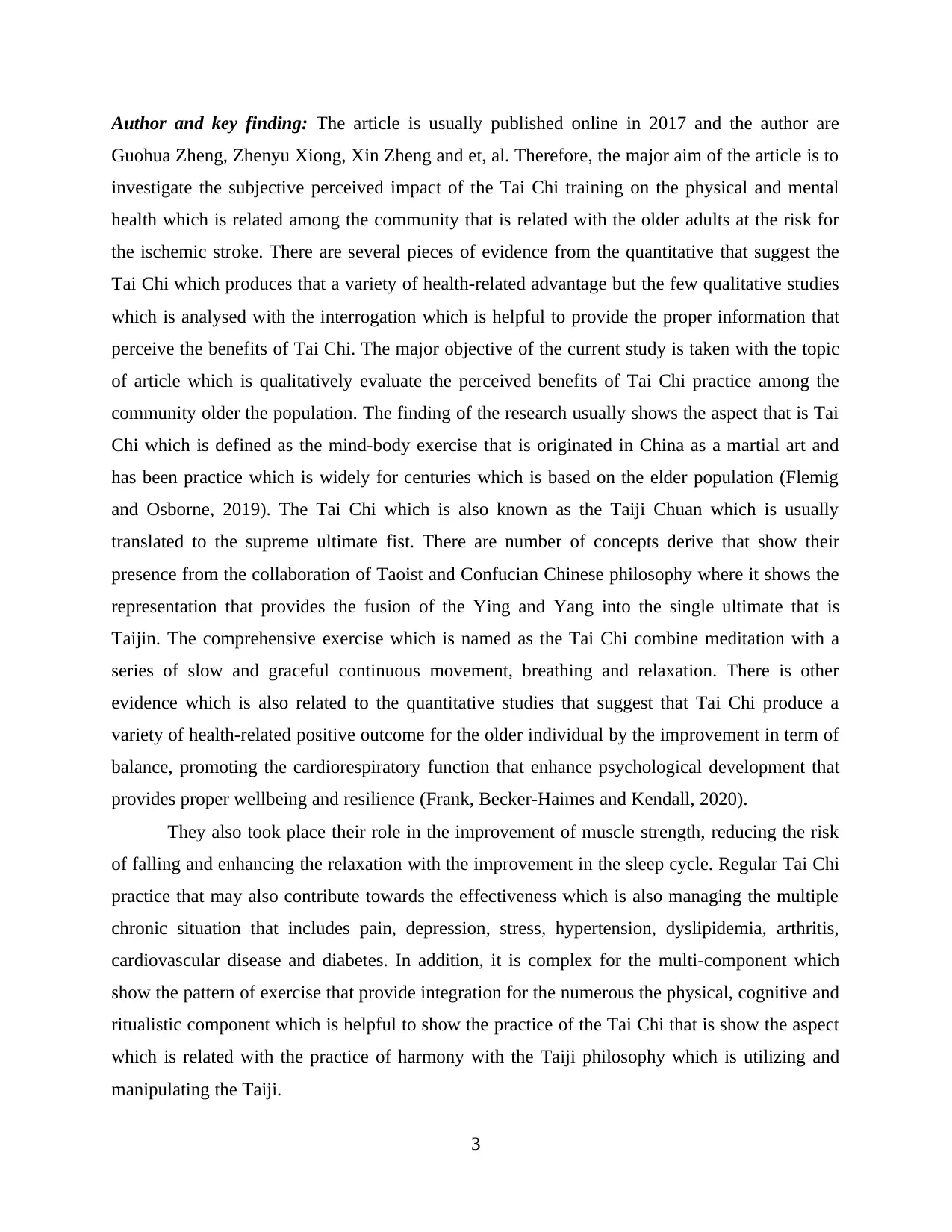
Author and key finding: The article is usually published online in 2017 and the author are
Guohua Zheng, Zhenyu Xiong, Xin Zheng and et, al. Therefore, the major aim of the article is to
investigate the subjective perceived impact of the Tai Chi training on the physical and mental
health which is related among the community that is related with the older adults at the risk for
the ischemic stroke. There are several pieces of evidence from the quantitative that suggest the
Tai Chi which produces that a variety of health-related advantage but the few qualitative studies
which is analysed with the interrogation which is helpful to provide the proper information that
perceive the benefits of Tai Chi. The major objective of the current study is taken with the topic
of article which is qualitatively evaluate the perceived benefits of Tai Chi practice among the
community older the population. The finding of the research usually shows the aspect that is Tai
Chi which is defined as the mind-body exercise that is originated in China as a martial art and
has been practice which is widely for centuries which is based on the elder population (Flemig
and Osborne, 2019). The Tai Chi which is also known as the Taiji Chuan which is usually
translated to the supreme ultimate fist. There are number of concepts derive that show their
presence from the collaboration of Taoist and Confucian Chinese philosophy where it shows the
representation that provides the fusion of the Ying and Yang into the single ultimate that is
Taijin. The comprehensive exercise which is named as the Tai Chi combine meditation with a
series of slow and graceful continuous movement, breathing and relaxation. There is other
evidence which is also related to the quantitative studies that suggest that Tai Chi produce a
variety of health-related positive outcome for the older individual by the improvement in term of
balance, promoting the cardiorespiratory function that enhance psychological development that
provides proper wellbeing and resilience (Frank, Becker‐Haimes and Kendall, 2020).
They also took place their role in the improvement of muscle strength, reducing the risk
of falling and enhancing the relaxation with the improvement in the sleep cycle. Regular Tai Chi
practice that may also contribute towards the effectiveness which is also managing the multiple
chronic situation that includes pain, depression, stress, hypertension, dyslipidemia, arthritis,
cardiovascular disease and diabetes. In addition, it is complex for the multi-component which
show the pattern of exercise that provide integration for the numerous the physical, cognitive and
ritualistic component which is helpful to show the practice of the Tai Chi that is show the aspect
which is related with the practice of harmony with the Taiji philosophy which is utilizing and
manipulating the Taiji.
3
Guohua Zheng, Zhenyu Xiong, Xin Zheng and et, al. Therefore, the major aim of the article is to
investigate the subjective perceived impact of the Tai Chi training on the physical and mental
health which is related among the community that is related with the older adults at the risk for
the ischemic stroke. There are several pieces of evidence from the quantitative that suggest the
Tai Chi which produces that a variety of health-related advantage but the few qualitative studies
which is analysed with the interrogation which is helpful to provide the proper information that
perceive the benefits of Tai Chi. The major objective of the current study is taken with the topic
of article which is qualitatively evaluate the perceived benefits of Tai Chi practice among the
community older the population. The finding of the research usually shows the aspect that is Tai
Chi which is defined as the mind-body exercise that is originated in China as a martial art and
has been practice which is widely for centuries which is based on the elder population (Flemig
and Osborne, 2019). The Tai Chi which is also known as the Taiji Chuan which is usually
translated to the supreme ultimate fist. There are number of concepts derive that show their
presence from the collaboration of Taoist and Confucian Chinese philosophy where it shows the
representation that provides the fusion of the Ying and Yang into the single ultimate that is
Taijin. The comprehensive exercise which is named as the Tai Chi combine meditation with a
series of slow and graceful continuous movement, breathing and relaxation. There is other
evidence which is also related to the quantitative studies that suggest that Tai Chi produce a
variety of health-related positive outcome for the older individual by the improvement in term of
balance, promoting the cardiorespiratory function that enhance psychological development that
provides proper wellbeing and resilience (Frank, Becker‐Haimes and Kendall, 2020).
They also took place their role in the improvement of muscle strength, reducing the risk
of falling and enhancing the relaxation with the improvement in the sleep cycle. Regular Tai Chi
practice that may also contribute towards the effectiveness which is also managing the multiple
chronic situation that includes pain, depression, stress, hypertension, dyslipidemia, arthritis,
cardiovascular disease and diabetes. In addition, it is complex for the multi-component which
show the pattern of exercise that provide integration for the numerous the physical, cognitive and
ritualistic component which is helpful to show the practice of the Tai Chi that is show the aspect
which is related with the practice of harmony with the Taiji philosophy which is utilizing and
manipulating the Taiji.
3
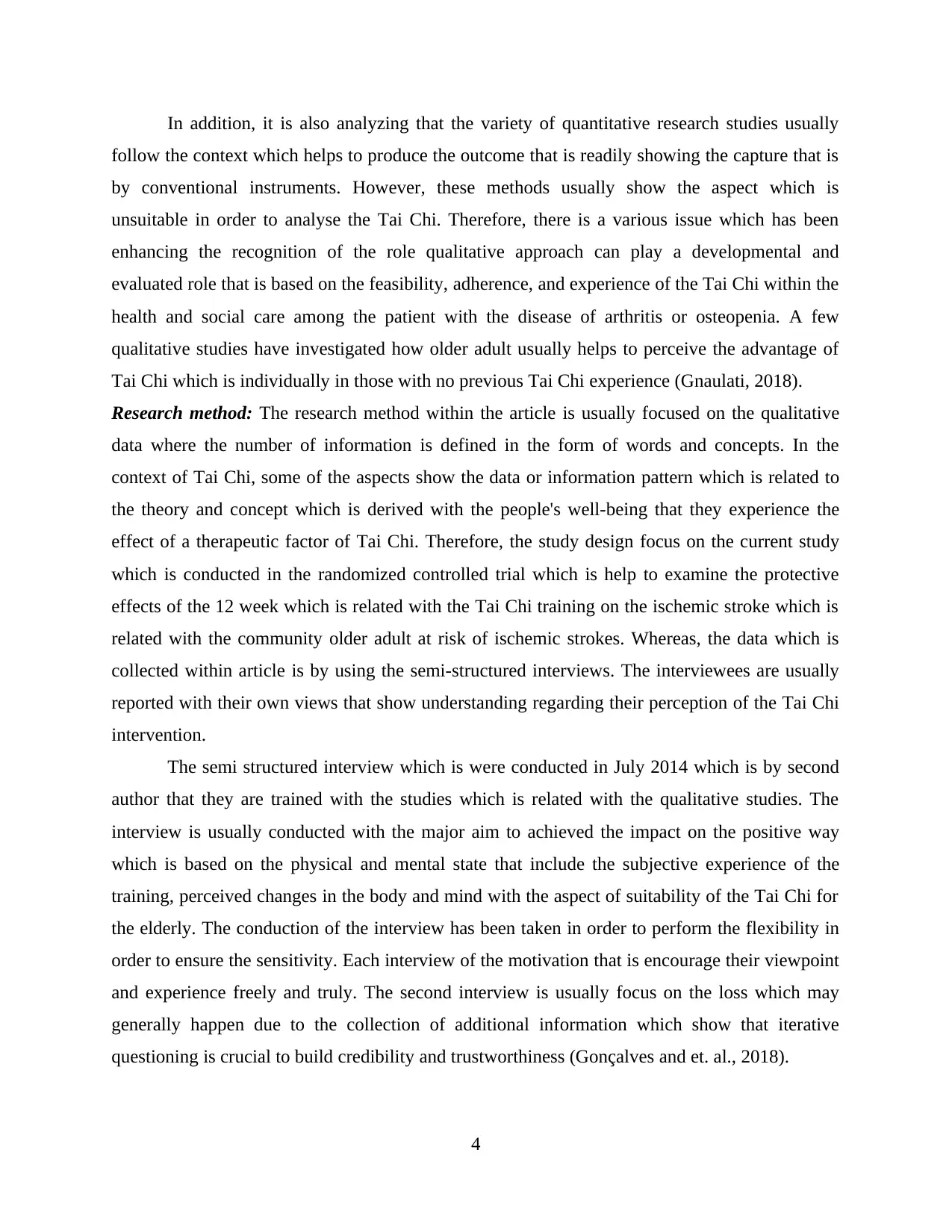
In addition, it is also analyzing that the variety of quantitative research studies usually
follow the context which helps to produce the outcome that is readily showing the capture that is
by conventional instruments. However, these methods usually show the aspect which is
unsuitable in order to analyse the Tai Chi. Therefore, there is a various issue which has been
enhancing the recognition of the role qualitative approach can play a developmental and
evaluated role that is based on the feasibility, adherence, and experience of the Tai Chi within the
health and social care among the patient with the disease of arthritis or osteopenia. A few
qualitative studies have investigated how older adult usually helps to perceive the advantage of
Tai Chi which is individually in those with no previous Tai Chi experience (Gnaulati, 2018).
Research method: The research method within the article is usually focused on the qualitative
data where the number of information is defined in the form of words and concepts. In the
context of Tai Chi, some of the aspects show the data or information pattern which is related to
the theory and concept which is derived with the people's well-being that they experience the
effect of a therapeutic factor of Tai Chi. Therefore, the study design focus on the current study
which is conducted in the randomized controlled trial which is help to examine the protective
effects of the 12 week which is related with the Tai Chi training on the ischemic stroke which is
related with the community older adult at risk of ischemic strokes. Whereas, the data which is
collected within article is by using the semi-structured interviews. The interviewees are usually
reported with their own views that show understanding regarding their perception of the Tai Chi
intervention.
The semi structured interview which is were conducted in July 2014 which is by second
author that they are trained with the studies which is related with the qualitative studies. The
interview is usually conducted with the major aim to achieved the impact on the positive way
which is based on the physical and mental state that include the subjective experience of the
training, perceived changes in the body and mind with the aspect of suitability of the Tai Chi for
the elderly. The conduction of the interview has been taken in order to perform the flexibility in
order to ensure the sensitivity. Each interview of the motivation that is encourage their viewpoint
and experience freely and truly. The second interview is usually focus on the loss which may
generally happen due to the collection of additional information which show that iterative
questioning is crucial to build credibility and trustworthiness (Gonçalves and et. al., 2018).
4
follow the context which helps to produce the outcome that is readily showing the capture that is
by conventional instruments. However, these methods usually show the aspect which is
unsuitable in order to analyse the Tai Chi. Therefore, there is a various issue which has been
enhancing the recognition of the role qualitative approach can play a developmental and
evaluated role that is based on the feasibility, adherence, and experience of the Tai Chi within the
health and social care among the patient with the disease of arthritis or osteopenia. A few
qualitative studies have investigated how older adult usually helps to perceive the advantage of
Tai Chi which is individually in those with no previous Tai Chi experience (Gnaulati, 2018).
Research method: The research method within the article is usually focused on the qualitative
data where the number of information is defined in the form of words and concepts. In the
context of Tai Chi, some of the aspects show the data or information pattern which is related to
the theory and concept which is derived with the people's well-being that they experience the
effect of a therapeutic factor of Tai Chi. Therefore, the study design focus on the current study
which is conducted in the randomized controlled trial which is help to examine the protective
effects of the 12 week which is related with the Tai Chi training on the ischemic stroke which is
related with the community older adult at risk of ischemic strokes. Whereas, the data which is
collected within article is by using the semi-structured interviews. The interviewees are usually
reported with their own views that show understanding regarding their perception of the Tai Chi
intervention.
The semi structured interview which is were conducted in July 2014 which is by second
author that they are trained with the studies which is related with the qualitative studies. The
interview is usually conducted with the major aim to achieved the impact on the positive way
which is based on the physical and mental state that include the subjective experience of the
training, perceived changes in the body and mind with the aspect of suitability of the Tai Chi for
the elderly. The conduction of the interview has been taken in order to perform the flexibility in
order to ensure the sensitivity. Each interview of the motivation that is encourage their viewpoint
and experience freely and truly. The second interview is usually focus on the loss which may
generally happen due to the collection of additional information which show that iterative
questioning is crucial to build credibility and trustworthiness (Gonçalves and et. al., 2018).
4
⊘ This is a preview!⊘
Do you want full access?
Subscribe today to unlock all pages.

Trusted by 1+ million students worldwide
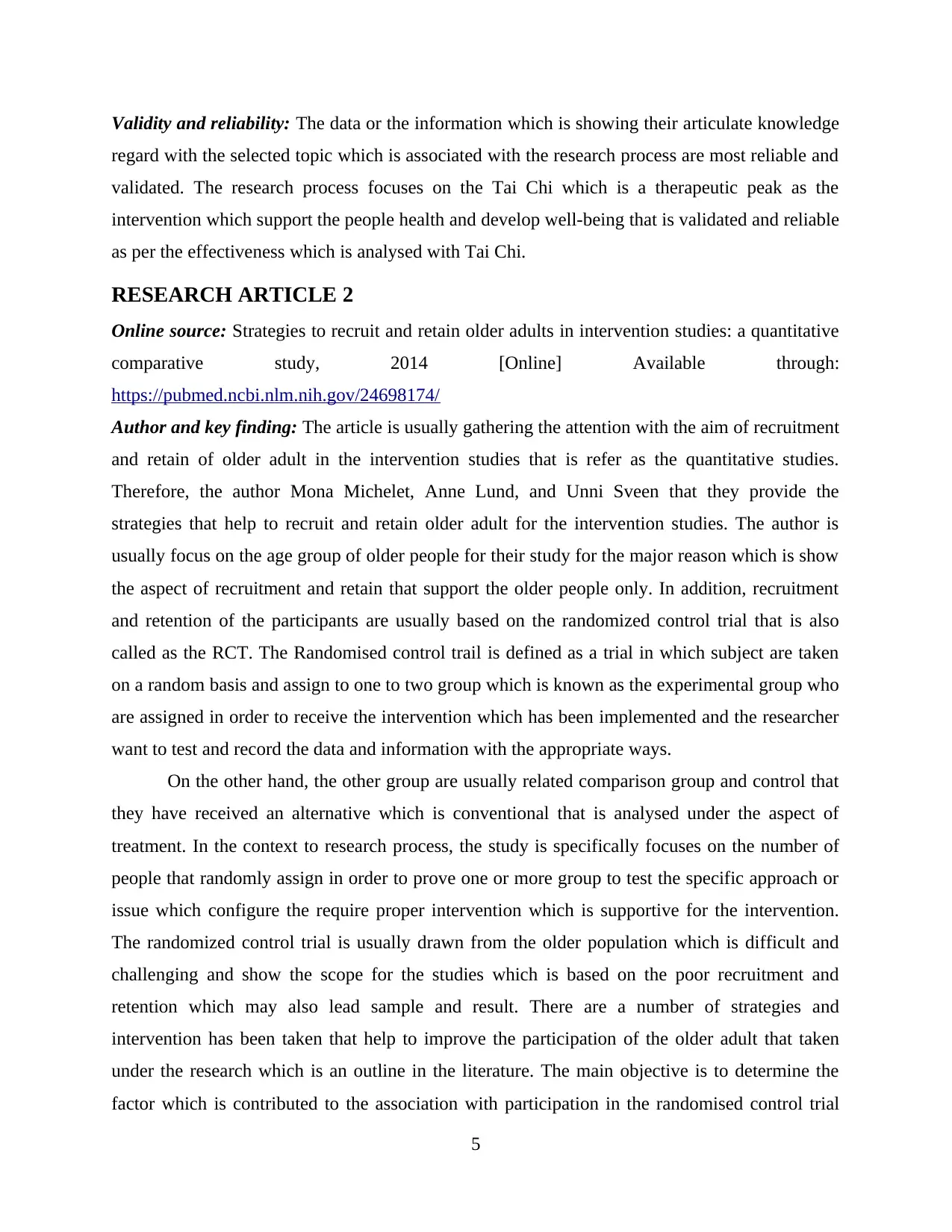
Validity and reliability: The data or the information which is showing their articulate knowledge
regard with the selected topic which is associated with the research process are most reliable and
validated. The research process focuses on the Tai Chi which is a therapeutic peak as the
intervention which support the people health and develop well-being that is validated and reliable
as per the effectiveness which is analysed with Tai Chi.
RESEARCH ARTICLE 2
Online source: Strategies to recruit and retain older adults in intervention studies: a quantitative
comparative study, 2014 [Online] Available through:
https://pubmed.ncbi.nlm.nih.gov/24698174/
Author and key finding: The article is usually gathering the attention with the aim of recruitment
and retain of older adult in the intervention studies that is refer as the quantitative studies.
Therefore, the author Mona Michelet, Anne Lund, and Unni Sveen that they provide the
strategies that help to recruit and retain older adult for the intervention studies. The author is
usually focus on the age group of older people for their study for the major reason which is show
the aspect of recruitment and retain that support the older people only. In addition, recruitment
and retention of the participants are usually based on the randomized control trial that is also
called as the RCT. The Randomised control trail is defined as a trial in which subject are taken
on a random basis and assign to one to two group which is known as the experimental group who
are assigned in order to receive the intervention which has been implemented and the researcher
want to test and record the data and information with the appropriate ways.
On the other hand, the other group are usually related comparison group and control that
they have received an alternative which is conventional that is analysed under the aspect of
treatment. In the context to research process, the study is specifically focuses on the number of
people that randomly assign in order to prove one or more group to test the specific approach or
issue which configure the require proper intervention which is supportive for the intervention.
The randomized control trial is usually drawn from the older population which is difficult and
challenging and show the scope for the studies which is based on the poor recruitment and
retention which may also lead sample and result. There are a number of strategies and
intervention has been taken that help to improve the participation of the older adult that taken
under the research which is an outline in the literature. The main objective is to determine the
factor which is contributed to the association with participation in the randomised control trial
5
regard with the selected topic which is associated with the research process are most reliable and
validated. The research process focuses on the Tai Chi which is a therapeutic peak as the
intervention which support the people health and develop well-being that is validated and reliable
as per the effectiveness which is analysed with Tai Chi.
RESEARCH ARTICLE 2
Online source: Strategies to recruit and retain older adults in intervention studies: a quantitative
comparative study, 2014 [Online] Available through:
https://pubmed.ncbi.nlm.nih.gov/24698174/
Author and key finding: The article is usually gathering the attention with the aim of recruitment
and retain of older adult in the intervention studies that is refer as the quantitative studies.
Therefore, the author Mona Michelet, Anne Lund, and Unni Sveen that they provide the
strategies that help to recruit and retain older adult for the intervention studies. The author is
usually focus on the age group of older people for their study for the major reason which is show
the aspect of recruitment and retain that support the older people only. In addition, recruitment
and retention of the participants are usually based on the randomized control trial that is also
called as the RCT. The Randomised control trail is defined as a trial in which subject are taken
on a random basis and assign to one to two group which is known as the experimental group who
are assigned in order to receive the intervention which has been implemented and the researcher
want to test and record the data and information with the appropriate ways.
On the other hand, the other group are usually related comparison group and control that
they have received an alternative which is conventional that is analysed under the aspect of
treatment. In the context to research process, the study is specifically focuses on the number of
people that randomly assign in order to prove one or more group to test the specific approach or
issue which configure the require proper intervention which is supportive for the intervention.
The randomized control trial is usually drawn from the older population which is difficult and
challenging and show the scope for the studies which is based on the poor recruitment and
retention which may also lead sample and result. There are a number of strategies and
intervention has been taken that help to improve the participation of the older adult that taken
under the research which is an outline in the literature. The main objective is to determine the
factor which is contributed to the association with participation in the randomised control trial
5
Paraphrase This Document
Need a fresh take? Get an instant paraphrase of this document with our AI Paraphraser
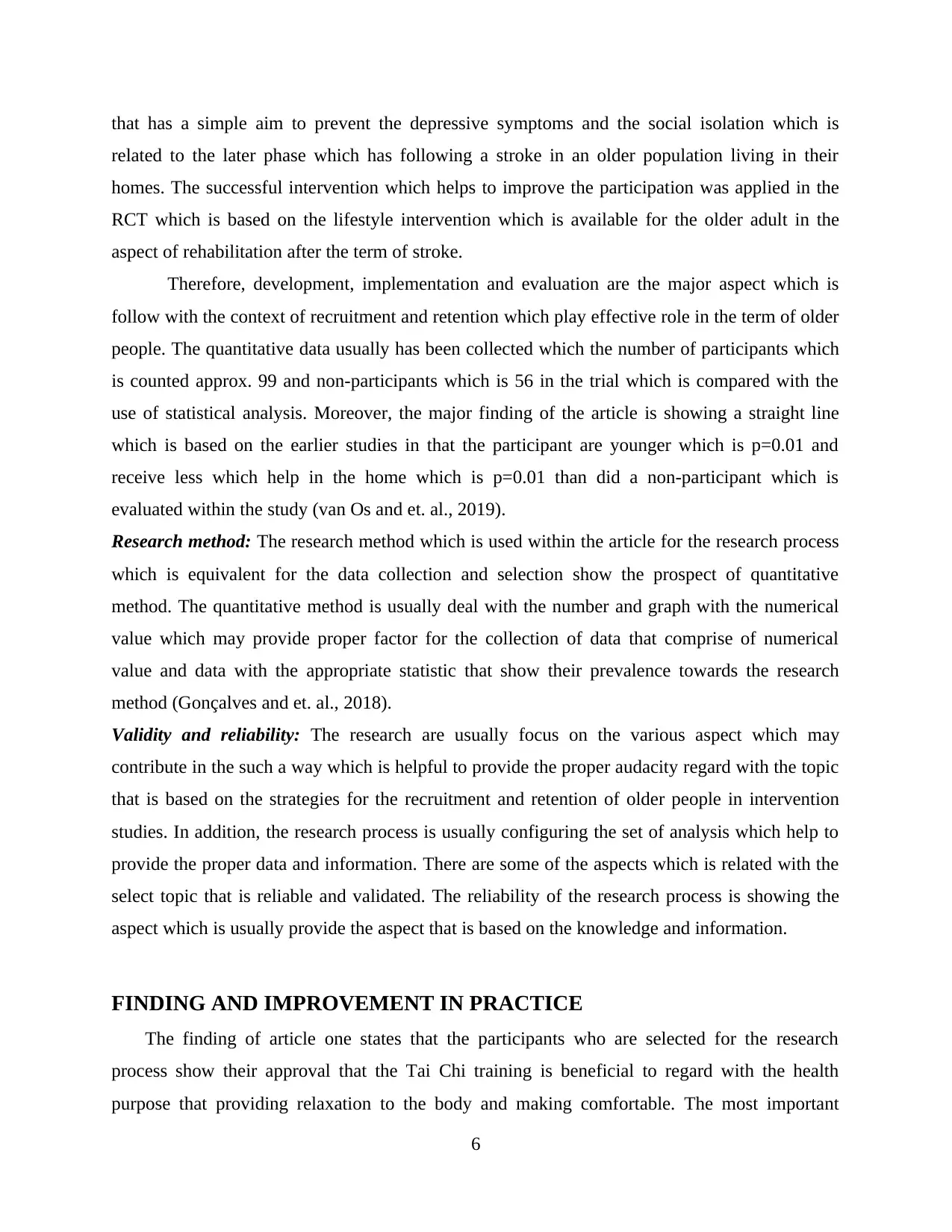
that has a simple aim to prevent the depressive symptoms and the social isolation which is
related to the later phase which has following a stroke in an older population living in their
homes. The successful intervention which helps to improve the participation was applied in the
RCT which is based on the lifestyle intervention which is available for the older adult in the
aspect of rehabilitation after the term of stroke.
Therefore, development, implementation and evaluation are the major aspect which is
follow with the context of recruitment and retention which play effective role in the term of older
people. The quantitative data usually has been collected which the number of participants which
is counted approx. 99 and non-participants which is 56 in the trial which is compared with the
use of statistical analysis. Moreover, the major finding of the article is showing a straight line
which is based on the earlier studies in that the participant are younger which is p=0.01 and
receive less which help in the home which is p=0.01 than did a non-participant which is
evaluated within the study (van Os and et. al., 2019).
Research method: The research method which is used within the article for the research process
which is equivalent for the data collection and selection show the prospect of quantitative
method. The quantitative method is usually deal with the number and graph with the numerical
value which may provide proper factor for the collection of data that comprise of numerical
value and data with the appropriate statistic that show their prevalence towards the research
method (Gonçalves and et. al., 2018).
Validity and reliability: The research are usually focus on the various aspect which may
contribute in the such a way which is helpful to provide the proper audacity regard with the topic
that is based on the strategies for the recruitment and retention of older people in intervention
studies. In addition, the research process is usually configuring the set of analysis which help to
provide the proper data and information. There are some of the aspects which is related with the
select topic that is reliable and validated. The reliability of the research process is showing the
aspect which is usually provide the aspect that is based on the knowledge and information.
FINDING AND IMPROVEMENT IN PRACTICE
The finding of article one states that the participants who are selected for the research
process show their approval that the Tai Chi training is beneficial to regard with the health
purpose that providing relaxation to the body and making comfortable. The most important
6
related to the later phase which has following a stroke in an older population living in their
homes. The successful intervention which helps to improve the participation was applied in the
RCT which is based on the lifestyle intervention which is available for the older adult in the
aspect of rehabilitation after the term of stroke.
Therefore, development, implementation and evaluation are the major aspect which is
follow with the context of recruitment and retention which play effective role in the term of older
people. The quantitative data usually has been collected which the number of participants which
is counted approx. 99 and non-participants which is 56 in the trial which is compared with the
use of statistical analysis. Moreover, the major finding of the article is showing a straight line
which is based on the earlier studies in that the participant are younger which is p=0.01 and
receive less which help in the home which is p=0.01 than did a non-participant which is
evaluated within the study (van Os and et. al., 2019).
Research method: The research method which is used within the article for the research process
which is equivalent for the data collection and selection show the prospect of quantitative
method. The quantitative method is usually deal with the number and graph with the numerical
value which may provide proper factor for the collection of data that comprise of numerical
value and data with the appropriate statistic that show their prevalence towards the research
method (Gonçalves and et. al., 2018).
Validity and reliability: The research are usually focus on the various aspect which may
contribute in the such a way which is helpful to provide the proper audacity regard with the topic
that is based on the strategies for the recruitment and retention of older people in intervention
studies. In addition, the research process is usually configuring the set of analysis which help to
provide the proper data and information. There are some of the aspects which is related with the
select topic that is reliable and validated. The reliability of the research process is showing the
aspect which is usually provide the aspect that is based on the knowledge and information.
FINDING AND IMPROVEMENT IN PRACTICE
The finding of article one states that the participants who are selected for the research
process show their approval that the Tai Chi training is beneficial to regard with the health
purpose that providing relaxation to the body and making comfortable. The most important
6
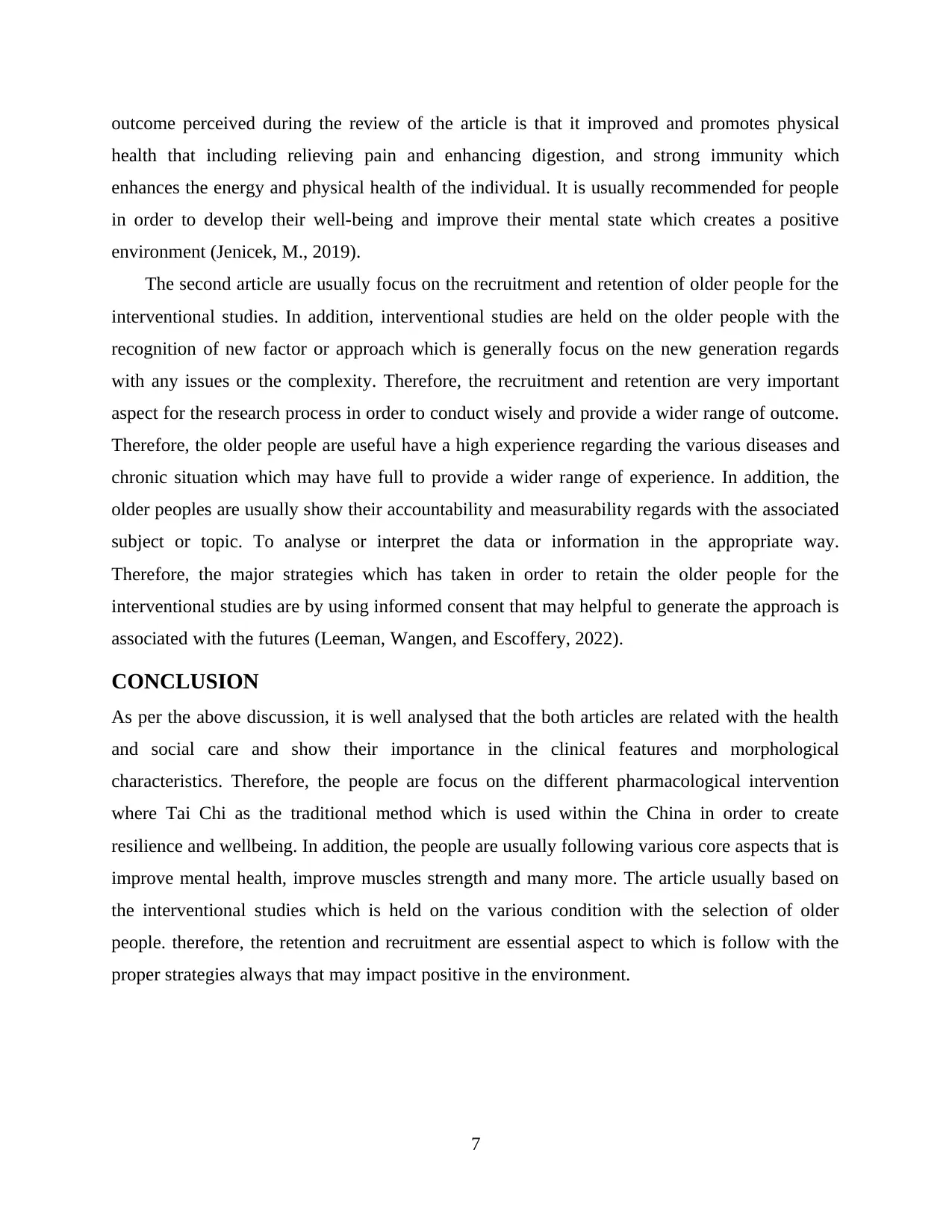
outcome perceived during the review of the article is that it improved and promotes physical
health that including relieving pain and enhancing digestion, and strong immunity which
enhances the energy and physical health of the individual. It is usually recommended for people
in order to develop their well-being and improve their mental state which creates a positive
environment (Jenicek, M., 2019).
The second article are usually focus on the recruitment and retention of older people for the
interventional studies. In addition, interventional studies are held on the older people with the
recognition of new factor or approach which is generally focus on the new generation regards
with any issues or the complexity. Therefore, the recruitment and retention are very important
aspect for the research process in order to conduct wisely and provide a wider range of outcome.
Therefore, the older people are useful have a high experience regarding the various diseases and
chronic situation which may have full to provide a wider range of experience. In addition, the
older peoples are usually show their accountability and measurability regards with the associated
subject or topic. To analyse or interpret the data or information in the appropriate way.
Therefore, the major strategies which has taken in order to retain the older people for the
interventional studies are by using informed consent that may helpful to generate the approach is
associated with the futures (Leeman, Wangen, and Escoffery, 2022).
CONCLUSION
As per the above discussion, it is well analysed that the both articles are related with the health
and social care and show their importance in the clinical features and morphological
characteristics. Therefore, the people are focus on the different pharmacological intervention
where Tai Chi as the traditional method which is used within the China in order to create
resilience and wellbeing. In addition, the people are usually following various core aspects that is
improve mental health, improve muscles strength and many more. The article usually based on
the interventional studies which is held on the various condition with the selection of older
people. therefore, the retention and recruitment are essential aspect to which is follow with the
proper strategies always that may impact positive in the environment.
7
health that including relieving pain and enhancing digestion, and strong immunity which
enhances the energy and physical health of the individual. It is usually recommended for people
in order to develop their well-being and improve their mental state which creates a positive
environment (Jenicek, M., 2019).
The second article are usually focus on the recruitment and retention of older people for the
interventional studies. In addition, interventional studies are held on the older people with the
recognition of new factor or approach which is generally focus on the new generation regards
with any issues or the complexity. Therefore, the recruitment and retention are very important
aspect for the research process in order to conduct wisely and provide a wider range of outcome.
Therefore, the older people are useful have a high experience regarding the various diseases and
chronic situation which may have full to provide a wider range of experience. In addition, the
older peoples are usually show their accountability and measurability regards with the associated
subject or topic. To analyse or interpret the data or information in the appropriate way.
Therefore, the major strategies which has taken in order to retain the older people for the
interventional studies are by using informed consent that may helpful to generate the approach is
associated with the futures (Leeman, Wangen, and Escoffery, 2022).
CONCLUSION
As per the above discussion, it is well analysed that the both articles are related with the health
and social care and show their importance in the clinical features and morphological
characteristics. Therefore, the people are focus on the different pharmacological intervention
where Tai Chi as the traditional method which is used within the China in order to create
resilience and wellbeing. In addition, the people are usually following various core aspects that is
improve mental health, improve muscles strength and many more. The article usually based on
the interventional studies which is held on the various condition with the selection of older
people. therefore, the retention and recruitment are essential aspect to which is follow with the
proper strategies always that may impact positive in the environment.
7
⊘ This is a preview!⊘
Do you want full access?
Subscribe today to unlock all pages.

Trusted by 1+ million students worldwide
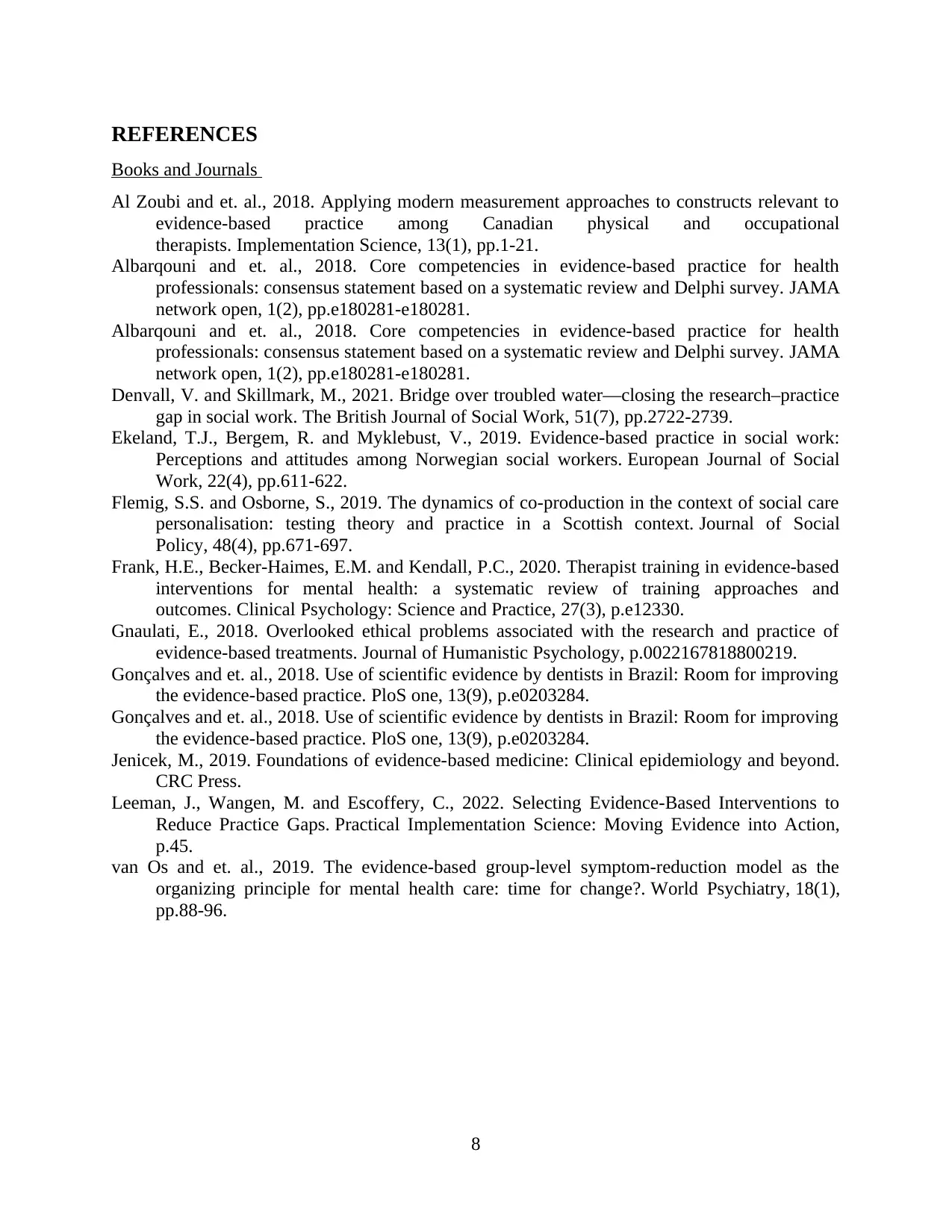
REFERENCES
Books and Journals
Al Zoubi and et. al., 2018. Applying modern measurement approaches to constructs relevant to
evidence-based practice among Canadian physical and occupational
therapists. Implementation Science, 13(1), pp.1-21.
Albarqouni and et. al., 2018. Core competencies in evidence-based practice for health
professionals: consensus statement based on a systematic review and Delphi survey. JAMA
network open, 1(2), pp.e180281-e180281.
Albarqouni and et. al., 2018. Core competencies in evidence-based practice for health
professionals: consensus statement based on a systematic review and Delphi survey. JAMA
network open, 1(2), pp.e180281-e180281.
Denvall, V. and Skillmark, M., 2021. Bridge over troubled water—closing the research–practice
gap in social work. The British Journal of Social Work, 51(7), pp.2722-2739.
Ekeland, T.J., Bergem, R. and Myklebust, V., 2019. Evidence-based practice in social work:
Perceptions and attitudes among Norwegian social workers. European Journal of Social
Work, 22(4), pp.611-622.
Flemig, S.S. and Osborne, S., 2019. The dynamics of co-production in the context of social care
personalisation: testing theory and practice in a Scottish context. Journal of Social
Policy, 48(4), pp.671-697.
Frank, H.E., Becker‐Haimes, E.M. and Kendall, P.C., 2020. Therapist training in evidence‐based
interventions for mental health: a systematic review of training approaches and
outcomes. Clinical Psychology: Science and Practice, 27(3), p.e12330.
Gnaulati, E., 2018. Overlooked ethical problems associated with the research and practice of
evidence-based treatments. Journal of Humanistic Psychology, p.0022167818800219.
Gonçalves and et. al., 2018. Use of scientific evidence by dentists in Brazil: Room for improving
the evidence-based practice. PloS one, 13(9), p.e0203284.
Gonçalves and et. al., 2018. Use of scientific evidence by dentists in Brazil: Room for improving
the evidence-based practice. PloS one, 13(9), p.e0203284.
Jenicek, M., 2019. Foundations of evidence-based medicine: Clinical epidemiology and beyond.
CRC Press.
Leeman, J., Wangen, M. and Escoffery, C., 2022. Selecting Evidence-Based Interventions to
Reduce Practice Gaps. Practical Implementation Science: Moving Evidence into Action,
p.45.
van Os and et. al., 2019. The evidence‐based group‐level symptom‐reduction model as the
organizing principle for mental health care: time for change?. World Psychiatry, 18(1),
pp.88-96.
8
Books and Journals
Al Zoubi and et. al., 2018. Applying modern measurement approaches to constructs relevant to
evidence-based practice among Canadian physical and occupational
therapists. Implementation Science, 13(1), pp.1-21.
Albarqouni and et. al., 2018. Core competencies in evidence-based practice for health
professionals: consensus statement based on a systematic review and Delphi survey. JAMA
network open, 1(2), pp.e180281-e180281.
Albarqouni and et. al., 2018. Core competencies in evidence-based practice for health
professionals: consensus statement based on a systematic review and Delphi survey. JAMA
network open, 1(2), pp.e180281-e180281.
Denvall, V. and Skillmark, M., 2021. Bridge over troubled water—closing the research–practice
gap in social work. The British Journal of Social Work, 51(7), pp.2722-2739.
Ekeland, T.J., Bergem, R. and Myklebust, V., 2019. Evidence-based practice in social work:
Perceptions and attitudes among Norwegian social workers. European Journal of Social
Work, 22(4), pp.611-622.
Flemig, S.S. and Osborne, S., 2019. The dynamics of co-production in the context of social care
personalisation: testing theory and practice in a Scottish context. Journal of Social
Policy, 48(4), pp.671-697.
Frank, H.E., Becker‐Haimes, E.M. and Kendall, P.C., 2020. Therapist training in evidence‐based
interventions for mental health: a systematic review of training approaches and
outcomes. Clinical Psychology: Science and Practice, 27(3), p.e12330.
Gnaulati, E., 2018. Overlooked ethical problems associated with the research and practice of
evidence-based treatments. Journal of Humanistic Psychology, p.0022167818800219.
Gonçalves and et. al., 2018. Use of scientific evidence by dentists in Brazil: Room for improving
the evidence-based practice. PloS one, 13(9), p.e0203284.
Gonçalves and et. al., 2018. Use of scientific evidence by dentists in Brazil: Room for improving
the evidence-based practice. PloS one, 13(9), p.e0203284.
Jenicek, M., 2019. Foundations of evidence-based medicine: Clinical epidemiology and beyond.
CRC Press.
Leeman, J., Wangen, M. and Escoffery, C., 2022. Selecting Evidence-Based Interventions to
Reduce Practice Gaps. Practical Implementation Science: Moving Evidence into Action,
p.45.
van Os and et. al., 2019. The evidence‐based group‐level symptom‐reduction model as the
organizing principle for mental health care: time for change?. World Psychiatry, 18(1),
pp.88-96.
8
Paraphrase This Document
Need a fresh take? Get an instant paraphrase of this document with our AI Paraphraser

9
1 out of 11
Related Documents
Your All-in-One AI-Powered Toolkit for Academic Success.
+13062052269
info@desklib.com
Available 24*7 on WhatsApp / Email
![[object Object]](/_next/static/media/star-bottom.7253800d.svg)
Unlock your academic potential
Copyright © 2020–2025 A2Z Services. All Rights Reserved. Developed and managed by ZUCOL.





